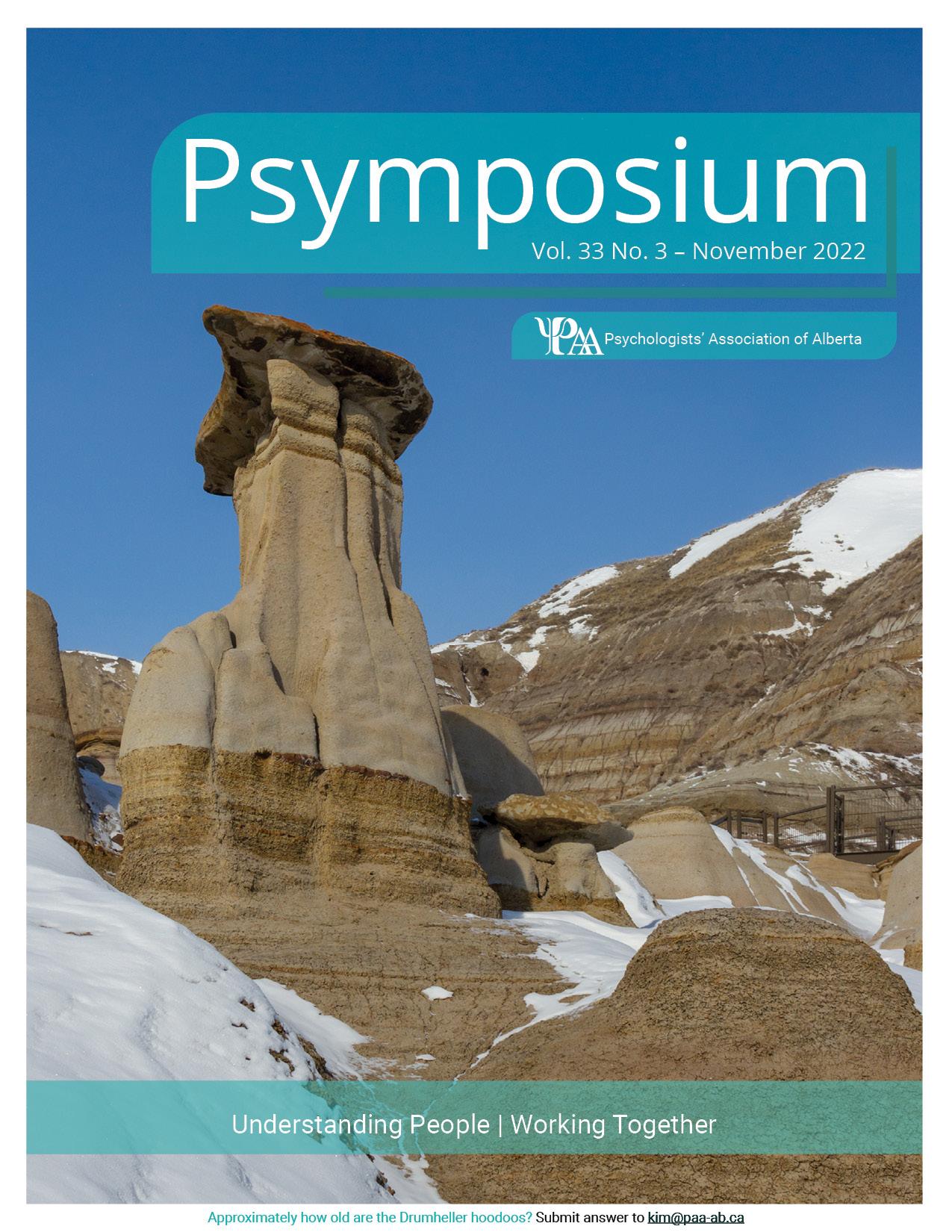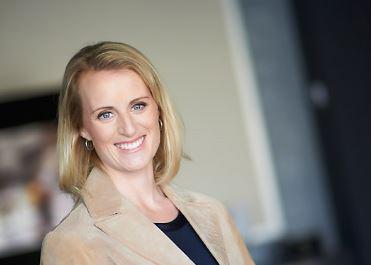Psymposium
Vol. 33 No. 4 – January 2023



all articles and submissions before publication and to decide on the suitability for publication.
PAA Psymposium is published five times a year (January, March, June, September, November) for the purpose of fostering communication amongst psychologists and supporting the goals of the Association and the profession of psychology. The newsletter is available to all members of the PAA on our website or by subscription, as well as to public subscribers and selected individuals and organizations with interests in the practice of psychology.
Except where otherwise indicated, copyright 1998 by the Psychologists’ Association of Alberta are in effect. Permission is granted to reproduce up to 10 copies of any article as it appears in PAA Psymposium, if such reproductions are distributed without profit for educational or research purposes only and properly cite Psymposium and denote PAA copyright. Permission for additional reproductions or reproduction for commercial purposes must be obtained in writing from the Editor-In-Chief. PAA generally welcomes requests to reprint from other professional newsletters.
Psymposium is submitted to PsycEXTRA, a database set up by the American Psychological Association, which contains newsletters, policy papers, white papers, fact sheets, reports, magazines. PsycEXTRA is a companion to the American Psychological Association’s scholarly database PsycINFO.



Psychologists’ Association of Alberta Suite 101, 1259–91 Street SW Edmonton, AB T6X 1E9 1-888-424-0297 paa@paa-ab.ca | www.paa-ab.ca
The mission of the PAA is to advance the sciencebased profession of psychology and to promote the well-being and potential of all Albertans. PAA & its members are recognized leaders in enhancing the psychological health of all Albertans
@PAAlberta @PAAlberta @psych.assoc.ab

“and
- J.R.R. Tolkien, Fellowship of the Ring
By Michelle Vandegriend, Ph.D., R. PsychIrecently came across a photo from when I spent three months in India more than twenty-five years ago. While travelling through Jaipur, I had the opportunity to go to the Jantar Mantar which holds Big Sundial, the largest stone sundial in the world. It stands approximately 27 meters tall and its shadow travels at one millimeter per second. It’s a busy world, and to me the photo is a reminder that time is precious.
Looking at the pages in my calendar for 2023, I’m reflecting on my work with couples and the ways in which couples can more meaningfully spend their time together when they come in asking for a “relationship checkup.” At a foundational level, as a Gottman Therapist I help couples integrate “small, positive things, often” to create a stronger connection in their relationship. Drs. John and Julie Gottman describe “the magic six hours” to a better relationship which focuses on spending a few minutes each day in the following areas:
• Partings–learn about one thing that may be happening in your partner’s day before leaving;
• Reunions–establish a “ritual of connection” on how you reunite at the end of your day and take a moment to listen to and inquire about each other’s experiences;
• Appreciation and Admiration–share positive actions you notice about your partner;
• Affection–build in moments of affection between each other;
• Plan for “dates” or “we time”–be intentional about planning time together, and dedicate moments throughout the week to learn more about your partner;
• and State of the Union Meeting–set aside time during the week to discuss an area of concern in a way that makes each other feel heard and understood.
Our time can so easily be compromised by a multitude of things in this world that grab our attention. Resetting our dial to intentionally focus on the small moments that matter throughout our days, weeks and months ahead can transform an “ok” relationship into a much more satisfying one.
With much gratitude, ~Michelle
PAA Member and Psymposium Editor-In-Chief Michelle Vandegriend, Ph.D., R. Psych. Certified Gottman Therapist www.stalbertcounselling.com Email: mvandegriend@stalbertcounselling.com

“I wish it need not have happened in my time,” said Frodo.
“So do I,” said Gandalf,
so do all who live to see such times. But that is not for them to decide.
All we have to decide is what to do with the time that is given us.”
 By Dr. Michael Stolte, R. Psych. (AB), PhD in Special Education
By Dr. Michael Stolte, R. Psych. (AB), PhD in Special Education

One of the benefits of being a member of the Technology in Practice Task Force is that we get to meet with experts in the field of psychology. In May of 2022, we met with Dr. Jonathan G. Perle, an American BoardCertified Child and Adolescent Psychologist, via video link. Among other titles, Dr. Perle is Director of Telepsychology in the Department of Behavioural Medicine and Psychiatry in the West Virginia School of Medicine. The purpose of the meeting was to get a better understanding of current changes in the field of telehealth, explore training opportunities, and hear from an expert on current ethical and legal challenges in the field.
As part of that conversation, Dr. Perle shared with us a book he had just published through Routledge – A Mental Health Provider’s Guide to Telehealth (2021) – which became one of my summer reads. Though the emphasis is on outpatient care in an American context, most of the information applies also to psychology in Canada. Dr. Perle introduces definitions of telehealth, numerous ethical and legal guidelines, minimum competencies and practice frameworks within a range of mental health disciplines, means to assess client suitability for telehealth, licensing and jurisdictional issues, software and hardware considerations, logistical considerations including minimum bandwidth, encryption standards, and videoconferencing platforms, room set-up considerations, documentation requirements, and self-care practices.
Though some of this information can feel a bit overwhelming, one of the most helpful items for me was the Simplified Videoconferencing Provider Checklist in the appendices (p. 193-194). Using a simplified checklist, information required for an ethical and effective videoconferencing telehealth session was listed. This included items such as
» verifying the appropriateness of the patient, location, and setting for video;
» gathering emergency information and contacts;
» verifying identity;
» verifying expectations for the session;
» verifying location;
» reviewing consents;
» testing equipment prior to the session;
» closing non-essential programs;
» ensuring confidentiality of the session;
» minimizing interruptions;
» documenting platform, rationale, and any potential issues.
A more comprehensive video conferencing checklist was also available, though seemed more appropriate as a training guide than for an individual session.
Though limited as it’s based on American privacy law, another section I found helpful was a listing of HIPAAcompliant levels of encryption for various types of data including email, documents / drives, document sharing programs, and phone messaging (p. 72). Though not exactly aligned with minimum ethical and legal standards in Canada, I found this was a helpful place to start in better understanding how many commonly used platforms are meeting (or not meeting) basic standards of security and encryption expected in health care settings. In our meeting with him, he also shared how many of the interjurisdictional licensing challenges I described in last month’s article are challenges that other jurisdictions are also navigating. In summary, though there are limitations for a Canadian context, I would recommend Dr. Perle’s newest book as a good resource for PAA members to access as they continue to learn more about providing effective and ethical telehealth.
Perle, J. G. (2021). A mental health provider’s guide to telehealth: Providing outpatient videoconferencing services. Routledge/Taylor & Francis Group. https://doi.org/10.4324/9781003150473
“Dr. Perle shared with us a book he had just published through Routledge – ‘A Mental Health Provider’s Guide to Telehealth’ (2021).”By Dr. Judi L. Malone, PAA CEO Registered Psychologist (AB/AUS)

Anew year is a new beginning – one rife with hope and promise. For me, January also represents a month for both reflection and planning. And gratitude for our profession, our association, and you, our members.
Psychologists are regulated health professionals who provide services including psychotherapy, assessment, diagnosis, and research of psychological health and problems. We are trained in evidence-based practices, and we follow a code of ethics that promotes respect for dignity and fair treatment. We have extensive credentials, supervised training, and complete rigorous examinations. We study the biological, cognitive, emotional, social, cultural, and environmental determinants of behaviour. Through such extensive research and practice, we help people cope more effectively in daily life.
We know how to help people deal with their feelings and attitudes and develop healthier and more effective patterns of behaviour. We are part of an extraordinarily diverse field with hundreds of career paths. In our work, we draw on an everexpanding body of scientific knowledge about how we think, act, and feel, and apply the information to their special areas of expertise.
We are the voice of, and for, psychology in Alberta. We are the voluntary body that advocates for psychology in Alberta, informs the public and the media, and advocates for consumers of psychotherapy, psychological, and mental health services. Our core values are psychological health, leadership, collaboration, and inclusion.
We provide professional development and networking opportunities for our members, have an active communications strategy, and operate a province-wide referral service. We support many initiatives that seek to enhance psychological health and wellness in our province.
We serve the public and you, our members, in eight languages and with more staff and services than any other psychological professional association in Canada. And everything we do is rooted in our strategic plan to: advocate for psychology’s unique value, promote the psychological health of all Albertans, enhance the development of psychologists across the career lifespan, focus on PAA’s membership value, and ensure financial sustainability.
We have this strength because of the strength of our profession. Because of the strength of our members. Thank you. I appreciate all that you do and your membership.
In closing…
There is value in psychology. February is national Psychology Month. Let’s celebrate the value and contributions of psychology together. This is your month to plan and next month, do share your Psychology Month celebrations with us using #ValuePsych. Together, we are psychology in Alberta.
Judi“Happiness is not out there for us to find. The reason that it’s not out there is that it’s inside us.”
- Sonja Lyubomirsky
With the start of a new year, PAA is pleased to open our Awards Program for new nominations. We count on you to bring deserving nominees to our attention, so that we can recognize them for contributions to the field of psychology in Alberta.

We have six Lifetime Achievement & Excellence Awards and three Research Awards available each year. Have a look at our awards page and see who comes to mind. It’s easy to nominate, and we’re here to help! Deadline for this award cycle is 30 April.
Help us acknowledge our own exemplars, honouring those who shape our profession in such meaningful ways.
Learn more on our Awards page and congratulations again to our 2022 winners!
» Psychologist of the Year Award–Dr. Gina Wong
» John G. Paterson Award–Dr. Jonathan N. Stea
» Pettifor Lifetime Achievement Award–Dr. Lloyd Flaro
» The Juanita Chambers Excellence in Community Service Award–Monica Mankowski
» Excellence in Clinical Supervision Award–Dr. Anusha Kassan
» Excellence in Teaching Psychology Award–Dr. Gina Ko
» Masters’ Thesis Research Award–Kristen Brown
PAA and our members are committed to maximizing our impact through strategic relationships with other psychology groups, in addition to maintaining a strong relationship with the College of Alberta Psychologists. This includes:
American Psychological Association
• Dr. Lana Hawkins was elected to the APA Council of Representatives
• Robert McGarva as Rural Health Coordinator
Representative for Alberta
• Dr. Judi Malone as the CESPPA representative for Alberta
• Nicki Wilson as Division 31 Representative
Canadian Council of Professional Associations of Psychology
• Dr. Judi Malone, Alberta Voting Participant
• Tammie Austin, Alberta Participant Observer
National Committee on Psychologist Wellness of ACPRO & CPAP
• Tatiana Lund, Student Volunteer
• Dr. Judi Malone, Co-Chair
Canadian Psychological Association
• Dr. Judi Malone serves on the CPA board representing the provinces Association of Canadian Psychology Regulatory Organizations
• Dr. Judi Malone serves as the liaison of the professional associations to ACPRO
Alberta Health Services
• Dr. Judi Malone participates in the:
» AHS Professional Practice Council for Psychology
» AHS Clinical Strategic Network for Addiction & Mental Health
» Alberta Mental Health Research Hub–Addictions & Mental Health
HappyNew Year! I hope that you found time to spend with those you love through the holidays, and I wish you all the best as we move into 2023.The holiday season always fills me with gratitude and hope. I am grateful for the people in my life and the opportunity to be part of a profession that brings me immense pride and fulfilment.
I am also grateful for all of you, your commitment to our profession, and your relationship with PAA. Your thoughts and opinions continue to shape the work that we do and have an impact across the province. Thank you for your input last month on our member survey. Your feedback in the following key areas will help to drive our future direction:

» Identity, Advocacy & Communications
» Benefit Partners
» PAA Programs & Services
» PAA Overall
PAA strives to advance the science-based profession of psychology and to promote the well-being and potential of all Albertans. Our vision is that the organization & its members are recognized leaders in enhancing the psychological health of all Albertans. As such, your voice and input are essential to us as we work to advocate, educate, and collaborate regarding the practice of psychology in our province.
With this in mind, PAA is excited to be launching a new Professional Guidance Program to support our members in working through ethical dilemmas that arise in our practice. This program will serve to provide resources, increase and focus our learning, and provide consultation to ensure that as psychologists, we may continue to provide robust and ethical services to those that we work with. As the program launches, I hope you will take some time to learn more about it and consider how the program may support you in your practice.
As we move into the new year, my wish for you is a renewed sense of hope and optimism for the year ahead. May you find fulfilment in your work, contentment in your day to day, and community in your collegial relationships. Wishing you all the best on behalf of the Board of Directors.
Claire Petersen, R. Psych, PAA Board President
• The right telehealth service provider will comply with privacy laws and ensure the security of the telehealth platform, not to mention the tremendous environmental benefits!
• According to the Canadian Medical Association (CMA), 47% of Canadians have used telehealth services during the pandemic.
Brought to you by PAA affinity partner Jane.app. Did you know? PAA members can get a 1-month grace period to your new account. Call PAA for the discount code.
“PAA is excited to soon be launching a new Professional Guidance Program to support our members in working through ethical dilemmas that arise in our practice.”












Irecently conveyed to a client that I feel most alive in my therapeutic and podcast work (againstracismpodcast.com). Some clients have asked me how it is possible to listen to problems all day. Upon reflection, I realize that I am listening to challenges and cultivating meaningful connections with clients. For example, I do not often discuss racism, microaggressions, and systemic oppression in my daily conversations. However, when clients bring up that they are experiencing such moments at work (for example), we pause, and I would gather more information, validate their experience, and ask how they feel and what they are ready to do about it. It is about honouring where they are at in the hurt or healing process. If talking about it in session is enough for the time being, that is what we will do. If they want to take action, we explore their support at work, whether they feel safe to say anything, and see if there are committees they can participate in so they can troubleshoot the system. Racialized clients point to the diversity and equity groups they can join in their organizations. The challenge is that it is challenging to fight uphill constantly, and it is unjust to expect racialized individuals to do the work in silos as it takes providing emotional labour and uprooting traumatic experiences. And unfortunately, their voices may not be heard. There needs to be systemic changes to amplify racialized voices and initiatives to bring forth real change in anti-oppression, anti-racism, and inclusion. Likewise, in my podcast, guests have spoken about moving beyond performative action to real action. Schools and organizations need to move beyond words and show that they are actually making a difference, such as increasing the representation of people of colour, especially in leadership roles. For example, the bamboo ceiling is a term created by Jane Hyun whereby Asians have difficulty advancing to upper management and leadership positions in the corporate world even though many Asians are educated with undergraduate and graduate degrees (Nunes, 2021). This is just one example of barriers that a racialized group faces in North America. When there are opportunities to pause and talk about such a concept, clients and podcast guests may feel seen and acknowledged. Hence, more meaningful narratives can be explored. This also ties into how I live my personal life. As a mother with teenage children (daughter and son), I do not shy away from heavy topics such as racism, sexism, heterosexism, ableism, and patriarchy. In fact, it is the moments when my children and I immerse in deep contemplation, deliberation, and open sharing, that I feel most connected to them. Over the years, I have learned so much from them, my clients, and my podcast guests. I hope that more individuals can find spaces and places where we feel most alive!
References available upon request.
“There needs to be systemic changes to amplify racialized voices and initiatives to bring forth real change.”
Most psychologists at one point in their career will be faced with an ethical concern or problem. As an ethical psychologist, it is important to weigh the risks and benefits of one’s actions in a particular situation and be aware of who is impacted.
As per the Canadian Code of Ethics, some ethical dilemmas may lead to an easy resolution. Others may lead to emotional distress and require time-consuming deliberation.
PAA is launching a new Professional Guidance Program to assist members in learning about and thinking through ethical dilemmas in their work as psychologists. Members will be able to request personal and confidential consultation by calling PAA or by submitting an online form.

This program will increase the support previously available to members via our award-winning Practice Advisor program, but access will no longer be limited to once annually. We also offer a range of ethical resources to help increase psychologist self-efficacy and ability to navigate ethical conflicts.
Ethical dilemmas can be very daunting and isolating. Through this program, we hope to give psychologists the support and confidence needed to face such decisions.
For more information, contact us at mattise@paa-ab.ca
Media Pieces
» Dr. Ganz Ferrance
» Dr. Linda Hancock
» Dr. Megan McElheran
» Dr. Brent MacDonald
» Dr. Michael Zwiers
» Dr. Judi Malone
» Dr. Harpreet Gill
» Kids, fear, and Halloween » From haunted houses to horror films, why an intentional scare can be fun » Good manners » Thank you, veterans » Opinion: Front-line workers are our heroes, but now they need to take care of themselves » Psychology of scary movies » Back to school anxiety- 3-part series » More adults being diagnosed with ADHD » Living with ADHD » Happy couples » The power of willpower » Family violence prevention awareness
Thank you to all PAA members taking an active role in our Task Forces and Communities of Practice (CoPs), including the following members in leadership roles:
Task Force Chairs
Awards Adjudicating Committee Chair – Dr. Judi Malone
PAA Racism in Alberta Psychology Task Force Co-Chairs – Mateo Huezo & Caryn Tong
Technology in Practice Task Force Co-Chairs – Dr. Michael Stolte & Trevor Josephson

Communities of Practice Executive Teams
Supervision CoP Chair – Dr. Terilyn Pott Moderator – Laura Friesen Publications Officer – Jessica Heil Engagement Officer – Aimee Reimer
Social Justice, Equity & Diversity CoP Chair – Joanna Card Vice-Chair – Krista Forand Engagement Officer – Shandra DeClerck
Public Education & Workplace Wellness CoP Chair – Inverpal Braich
Rural & Northern Psychology CoP Chair – Laura Friesen Vice-Chair – Kirsten Timpany Moderator – Dr. Terilyn Pott Publications Officer – Laurelle St. Jean
Indigenizing Psychology CoP Chair – Michael Yankowski Vice-Chair – Jasmine Fouillard Moderator – Mark Nicoll Moderator – Kirsty Keys Publications Officer – Danae Laut
Clinical/Counselling Psychology CoP Chair – Inverpal Braich Vice-Chair–Dr. Zoey Zhang


Itis time for psychologists to have a choice to consider officially using the term “patient” as well as continuing to use the word “client.” During this century, there has been a significant increase in our specialized knowledge and skills, partially due to the functional technologies that are now available. We can now “treat” patients so that they can be mentally, emotionally and somatically healthier. Psychosocial psychologists also deal with increasing numbers of life-and-death situations such as preventing suicide, the aftermath of motor vehicle and other types of accidents, as well as abuse of all kinds.
The fundamental reason to clarify using “patient” is that in the Psychology Standards of Practice Definition Section, patient is defined as “considered synonymous with client” whereas client is defined as “a recipient of professional services.” There is no mention in the Standards of defining how treatment is different from being a “recipient” of professional services.
The description of treatment and patient is described in the Alberta Governance of Health Professions Summary, Overview Section titled “Psychosocial interventions: an interpretive guide to the restricted activity.” It is noted in this interpretive guide that there is no mention of clients, only patients. It states:
Some activities may be restricted under certain circumstances. For example, psychosocial interventions are restricted activities only when performed with an intention to treat the patients with specific disorders.
Reference: https://www.alberta.ca/regulated-healthprofessions.aspx
This Government of Alberta interpretive guide uses the July 1, 2014 description of psychosocial restricted activity as
follows:
Restricted activities are health services which can only be performed by authorized persons, because of the risks associated with the performance of these activities and the need to ensure that practitioners possess the necessary competencies. Psychosocial interventions are treatments such as cognitive–behavioural therapies, behaviour modification, counselling and supportive psychotherapy, and psychoanalysis. This document is intended to assist employers, practitioners and others in understanding when psychosocial intervention is a restricted activity and which practitioners can perform restricted psychosocial interventions.
One could also argue that the definition of patient needs to be modernized. Modernized is the term used by the Alberta Government to describe changes in the Health Professions Act. The definition of client also needs to be modernized to broaden the scope of client work from just being “a recipient of professional services.” Neither patient nor client is a one-way, top-down approach.
ACTION: There needs to be collective advocacy to develop a new definition so we can have an informed choice that clarifies when to use the term “patient.” I invite you to comment in PAA Collaborate where I have written a similar article (under Registered Psychologists / Threads) requesting your opinions and your pros and cons of using patient or client.
Please visit Collaborate https://collaborate.paa-ab.ca/ and reply by February 15, 2023. Your comments are an important contribution to developing definitions. Much appreciation to those who have already commented; your comments have already made a difference. I will let you know the results of this survey.
“Please visit Collaborate and reply by February 15, 2023.”

Asprofessionals, and as a profession, there is all too often a desire for rules that would not only govern our behaviour but protect us from complaint. In a recent book, How Rights Went Wrong, Jamal Greene provides a frame of reference for ethical decision-making. In speaking of constitutional law in the United States, he describes a process that would serve our profession.
In ethics consult, the person calling often just wants an answer, and that answer is how they should act: “what is the rule?” For Greene, ‘rules’ are laws. Greene’s standards however are more like mores; contemporary social, intellectual, or political values that constitute overt and covert issues which guide one’s thoughts. Greene illustrates the distinction with the gay wedding cake legal case. Briefly, a bakery in the United States refused to bake a wedding cake for a gay couple. The issue was how rules against discrimination would be interpreted relative to standards which point to freedom of expression/religion. Though the initial finding was overturned, not baking was initially ruled discriminatory. However, the standards around the law/”rule” led to a discussion of proportionality. Proportionality refers to how standards and rules might be exercised. For example, would a bakery be considered discriminatory if it didn’t make donuts? Could donut lovers claim discrimination? Less ridiculously, could a baker refuse to prepare an erotic cake (yep, they exist) or a cake expressing racist sentiment? It is in proportionality that the answer may emerge. It is with this distinction between “standards”/social issues and “rules” that the conversation is useful to us.
Rules, for us, are reflected in specific expectations for our profession: our Code of Ethics and Standards of Practice, addressing topics such as erotic prohibitions, record-keeping, accountability to patients, and conduct with vulnerable populations. Greene’s social/cultural/ intellectual/political “standards” are prosthetics to these rules, the aspirational ideals of the profession, and a sense of what fairness means. Proportionality involves contextual
consideration. Contextual consideration is messy: issues, values, particulars, history, motivations, and related aspects surrounding any ethical matter. What circumstances amplify or mitigate against a particular ethical/standard of practice? What factors are relevant in pursuit of a just and fair outcome? Yet there is a rub. In such a process there is potential for different outcomes, different resolutions: one person arranging data to see one thing and another person arranging data to see something else! Depp vs Heard eh? As result, we need a few bright lights to guide us in any ethical investigation, consultation, or discussion.
First: we need to ensure that context/standards do not blind us to the egregious. For years, sexual misconduct was relativized through contemporary morals, values, and politics and hence not addressed sufficiently. In our profession, context ought not to override legal matters, financial misconduct, erotic conduct, and the like.
Second: is the matter more about minimizing responsibility and accountability than reflective of how a psychologist would think about it? For years, one of the first questions I would ask in investigation related to erotic involvement was “What was your thought process that led to crossing this clear boundary as outlined in ethics?” And the usual response is ‘what? Huh?’ followed by rationalization, justification, and self-defence.
Third: how will actions relative to any decision be AND look fair? In the congressional review of Ketanji Brown Jackson for the Supreme Court, the best the Republicans could do was show her record on defendants guilty of sexual offense, acting as if light sentences reflected her attitude in this area of jurisprudence. How would this look to this or that public?
Finally: history will always be the judge relative to ideas provided or actions taken. The goal is to be on the right side of history, but that is not guaranteed. Summarily, this means that if we are wrong, we want it to be an honest mistake; one that has arisen from deliberate and reflective action reflecting the ethos of our profession, not personal or self-serving interest nor escape from responsibility.
“If we are wrong, we want it to be an honest mistake; one that has arisen from deliberate and reflective action reflecting the ethos of our profession.”
 Releasing Emotional Pain
By Gwen Randall-Young, R. Psych
Releasing Emotional Pain
By Gwen Randall-Young, R. Psych
Sometimes there are people in our lives with whom we have painful connections. It might be a parent, who we hold responsible for a difficult childhood, a friend who has betrayed us, an ex-partner, or a supervisor or colleague in the workplace. Those relationships may remain unresolved, either because raising the issues may create more difficulty, or because we simply do not want the relationship anymore. Either way, as we try to move on, we may find we take the pain with us.
Is it that the person hurt us so deeply that our wounds just will not heal? Or is the pain in part our own creation? Either, or both, of the above, may be true, but the second option is the only one that allows us to create a different future for ourselves.
When we talk about creating our own pain, this does not mean that we have somehow ‘attracted’ painful situations to facilitate our learning. It means the situation in itself is not the problem, but rather it is our response to the situation which creates the pain. It is our holding on and continuing to put our energy into the memory of the problems that keeps the pain alive and thriving in our consciousness.
If we keep thinking about it, keep talking about it, and begin to define ourselves in terms of what happened to us in the past, then we bind that pain to ourselves. This does not mean we should suppress pain. It is important to talk about what has happened to us, but the goal is to heal it and move on, not to keep etching it deeper and deeper into our psyches. Fueling vindictive feelings only creates more toxic energy. This kind of toxic energy hardens our hearts.
The tendency to hold on to pain, almost like an emotional constipation, may in part be genetic. I know of one family in which for at least three and perhaps even four consecutive generations, there was one sibling who stopped speaking to one or more of the other siblings, and the silence lasted for decades until death. The individual held on to perceived slights, ruminated and obsessed about them, and never let go.
Genetics can contribute to creating predispositions, not destinies. A family history of pain and suffering is all the more reason to work to change the pattern, rather than unconsciously passing it on.
Letting go of pain does not mean that whatever someone has done to us is okay. It only means we choose not to spend the rest of our lives suffering from it. Others can inflict pain upon us, but only we can release ourselves from emotional pain. It takes a lot of energy to maintain the pain, and so releasing it frees up large stores of energy for creativity, love, and moving forward in our lives.
Gwen Randall-Young is an author and award-winning psychologist. For permission to reprint this article, or to obtain books, CDs or MP3s, visit www.gwen.ca. Follow Gwen on Facebook for inspiration.

“Even the smallest shift in perspective can bring about the greatest healing.”
- Joshua Kai
The following recommended fee schedule changes are effective January 1, 2023.
Changes are made to the recommended fee schedule only after extensive research, consultation and board deliberation. These are recommended fees for service and used in PAA’s advocacy with third-party payers. Registered psychologists in Alberta set their own rates.
Individual Therapy/Assessment $220

Expert Witness Testimony (half-day minimum fee) $1,300

Expert Witness Testimony (full-day minimum fee) $2,600
Consultation/Corporate Services (half day) $1,000



Consultation/Corporate Services (full day) $2,000



» Report writing, telephone consultation, letters, and form completion are billed at the rate of the service being provided.
» Billing can also occur in 10-minute increments for services done outside the therapy hour such as phone calls, letters, and the like calculated at one-fifth the hourly rate for every 10 minutes. Incremental billings are also appropriate for services provided beyond a 50-minute session.
» Fees for specialized services & treatments not listed on the above schedule may exceed the current recommended guidelines.






Growing Together is for members who are students, Provisionally Registered Psychologists (PRP), or Early Career Psychologists (ECP). This feature is presented by your PAA Board Representatives. Contact them with questions!

» Student members: Katherine at katherine.archibald@ucalgary.ca

» PRP members: Samantha at samleegruber@gmail.com
» ECP members: Sandra at womanofinfluence1@yahoo.com
upcoming ECP Wellness Corner session in January 2023 that will be addressing Professional
Kickstartyourcareerwith Checkanewvolunteerposition. out what’s available on Collaborate



A key goal of the ECP Group is to create a safe space of cultural safety where we can share with each other and also be heard without judgement.



Our new and improved Collaborate is up and running! Collaborate is our online members-only platform for discussions, libraries of shared resources, events, and so much more. Many of our Volunteer Engagement Executives are organizing and holding virtual meet-ups where you can connect with other PAA members who have similar interests. Join communities of practice that interest you for access to with
 Paid advertisement
Paid advertisement
Virtual, 20 January 2023 | 6 CE Credits
Preparing to pass the EPPP and Register as a Psychologist in Alberta–with Dr. Thérèse Chevalier


Mastering Learning Strategies: Memory Boosting Learning Strategies for the EPPP–with Michele Pentyliuk, M.Ed. Register
Virtual, 25 January - 05 April 2023 | Matthew McKenzie Bain | 6 CE Credits
Personality is a word that is often misunderstood and misapplied. A model for the New Big Five is used to zoom in on personality. This bi-weekly webinar series consists of six one-hour sessions: 25 Jan to 05 Apr 2023. Register before 25 Jan
Evidence-Based Practice in Psychology
Edmonton, 27 January 2023 | Cody Guy House Psy.D. | 6 CE Credits
Three major aspects of evidence-based practice will be emphasized: (1) empirically supported treatments (e.g., manualized and principle based protocols), (2) evidence-based psychotherapy relationships and responsiveness, and (3) routine outcome/progress monitoring. Register
Virtual, 02 February 2023 | Megan McElheran, Ph.D. | 6 CE Credits

The workshop will address those with an existing knowledge base who are interested in developing greater clinical skills and understanding related to the first responder population. Register
One-hour recorded overview of the topic. Watch anytime, anywhere ($40 + GST).
Assessing Perinatal Mental Health–Kristine Aanderson, Mallory Becker and Dr. Gina Wong Psychedelics and Psychedelic-Assisted Therapy–Megan McElheran, Ph.D. Prescribing Service Dogs or Emotional Support Animals–Kristine Aanderson
The Erupting Addictions Pandemic–Dr. Kevin Alderson

The Game of Life: An Introduction to Using Basic Sport Psychology Principles in Clinical Practice–Dr. Caelin White Family Restructuring Therapy–Dr. Stephen Carter Trauma & PTSD in First Responder Populations–Dr. Megan McElheran
Psychology of Cannabis Addiction–Dr. Jonathan Stea Preparing for Cannabis Legalization: A Psychologists’ Evidence-based Guide–Dr. Igor Yakovenko

Are you marketing your private practice effectively?

The PAA Referral Service provides the public with the contact information of registered psychologists who match their region/area of expertise. With excellent value for your marketing dollar investment, the Referral Service is an ideal advertising strategy for those in private practice.
New feature! Early Career and Provisional members—you are now eligible for the Referral Service too!
Already on the Referral Service? Use our series of videos for your marketing purposes.
Joining the Referral Service is easy—it’s an add-on to your PAA membership. The annual fee is $200.00 plus GST (prorated after 01 May), and you can add a direct link to your website for $53.00 + GST.
From Oct to Nov 2022, we averaged
referrals/month. That’s
per day.